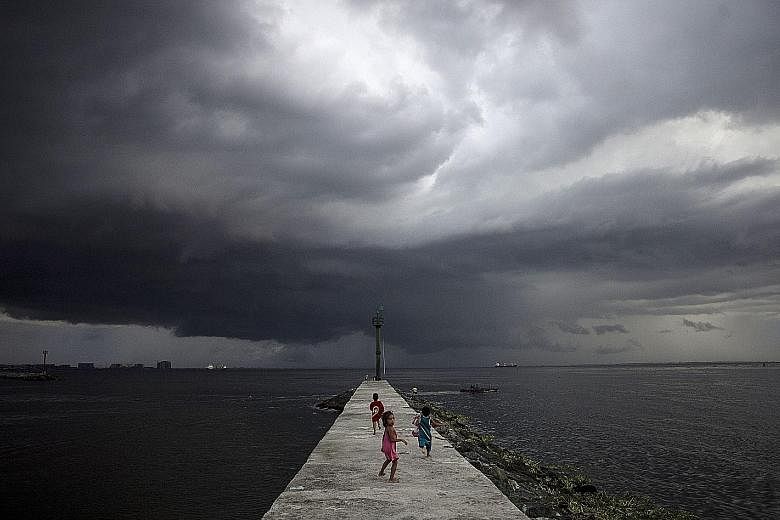BANGKOK • Climate change will bring soaring temperatures, more intense storms, erratic rainfall, plummeting crop yields and a collapse of coral reefs to the Asia-Pacific unless countries fully implement their commitments under the Paris climate pact, scientists said yesterday, calling the challenges "unprecedented".
That means quickly cutting carbon pollution from burning fossil fuels and investing in cleaner sources of energy, said a report by the Asian Development Bank (ADB) and the Potsdam Institute for Climate Impact Research.
The region's future growth and security - as well as the welfare of hundreds of millions of people - are at stake, the report said.
"Countries in Asia and the Pacific are at the highest risk of plummeting into deeper poverty - and disaster - if (climate change) mitigation and adaptation efforts are not quickly and strongly implemented," said Mr Bambang Susantono, vice-president for sustainable development at ADB.
Unabated climate change threatens to undo many of the region's development advancements, not least by incurring high economic losses, the Manila-based bank said.
The landmark 2015 Paris Agreement, which came into force last November, pledges to limit the rise in average global temperatures to below 2 deg C above pre-industrial levels and ideally cap the rise at 1.5 deg C. The global surface temperature has already risen by about 1.1 deg C since the beginning of the Industrial Revolution, the World Meteorological Organisation said.
Early and aggressive measures are needed to achieve that goal, the report said. If the world continues to emit greenhouse gases at current growth rates, the global mean temperature would increase by more than 4 deg C by the end of the century, with parts of the Asia-Pacific seeing a rise of 6 deg C or even higher.
-
SOME KEY PROJECTIONS
-
• All coral reef systems in the Western Pacific will collapse due to mass coral bleaching if global warming increases by 4 deg C. Even with a 1.5 deg C increase, 89 per cent of coral reefs are expected to suffer from serious bleaching, severely affecting reef-related fisheries and tourism in South-east Asia.
• Sea levels could rise by 1.4m if temperatures increase by 4 deg C.
• Nineteen of the 25 cities most exposed to a 1m sea-level rise globally are in the Asia-Pacific, seven of them in the Philippines.
• Indonesia would be the Asian country worst affected by coastal flooding, with about six million people expected to be hit each year until 2100.
• With a 4 deg C temperature rise, annual precipitation is expected to increase by up to 50 per cent over most land areas in the region, while some nations like Pakistan and Afghanistan may experience a 20 to 50 per cent decline in rainfall.
• Of the top 20 cities with the largest projected increase in annual flood losses between 2005 and 2050, 13 are in Asia - located in China, India, Vietnam, Indonesia, Thailand and Japan.
• Rice yields in some South- east Asian countries could decline by up to 50 per cent by 2100 if no climate change adaptation efforts are made.
REUTERS
This would bring drastic changes in the region's weather, biodiversity, agriculture and fisheries, and drive migration as some parts become less habitable. "Such a scenario may even pose an existential threat to some countries in the region, and crush any hope of achieving sustainable and inclusive development," the ADB said.
The Asia-Pacific is home to two-thirds of the world's population, with nine out of 15 countries listed as most vulnerable to natural hazards globally.
Asia's global economic links mean that extreme climate events could disrupt supply chains not only in the region but also in the rest of the world, the ADB warned.
Cities are particularly vulnerable, the report said. Asia is becoming increasingly urban and coastal, placing cities and their growing populations at greater risk from rising sea levels and extreme weather, as well as disruption to food and water supplies from droughts and floods inland.
Heatwaves are another threat. "Already today, the number of hot days in cities is twice as high as in the hinterland. By the end of the 21st century, this number could be 10 times higher," the report said.
Many countries in the region still rely heavily on fossil fuels for energy. The ADB said it would invest US$4 billion (S$5.5 billion) by 2020 to promote renewable energy supplies and green growth across the region.
REUTERS, AGENCE FRANCE-PRESSE

